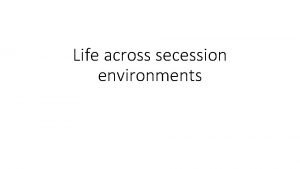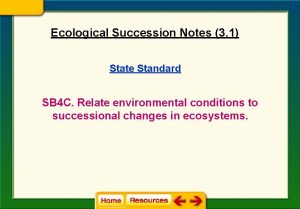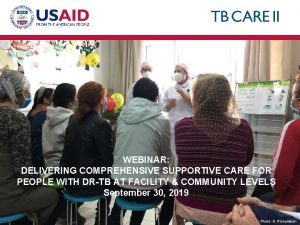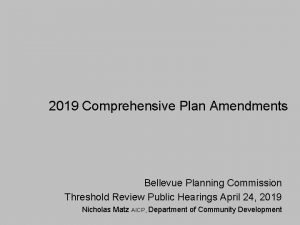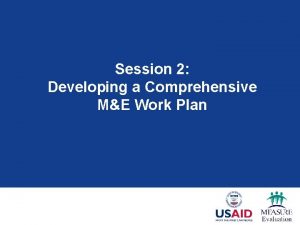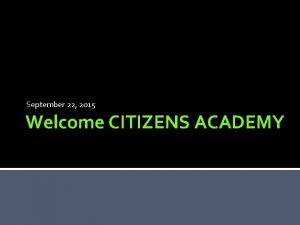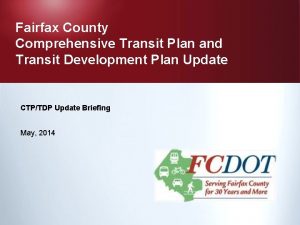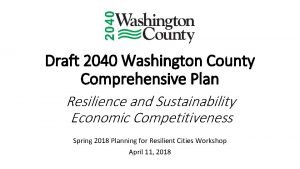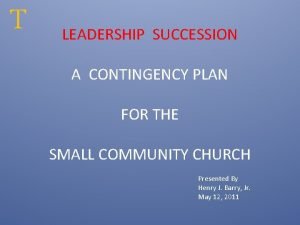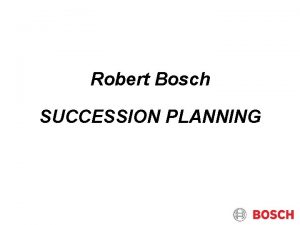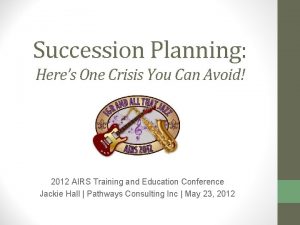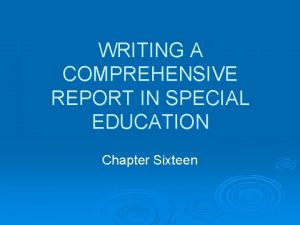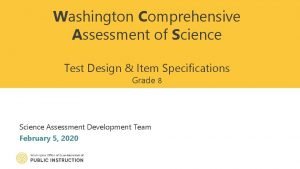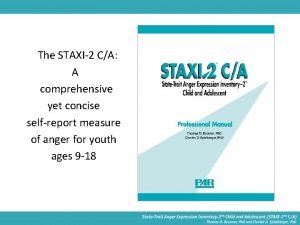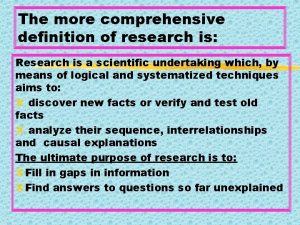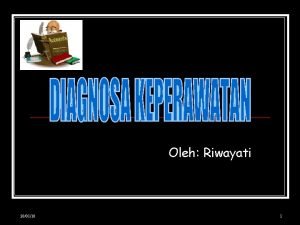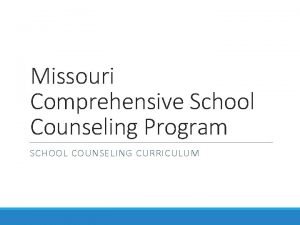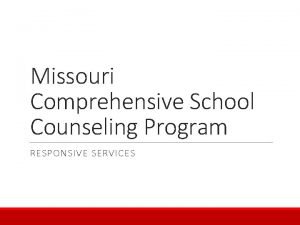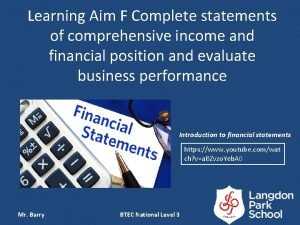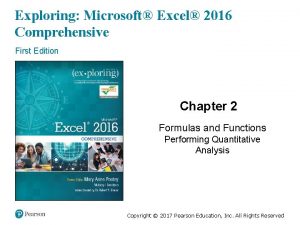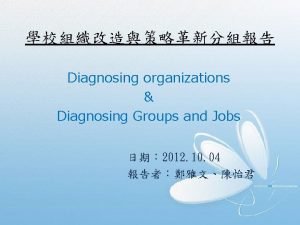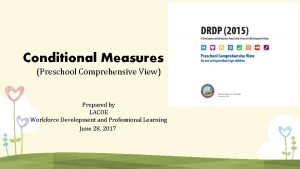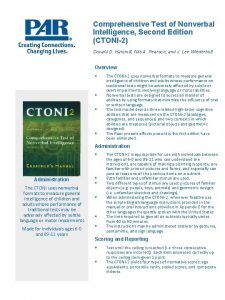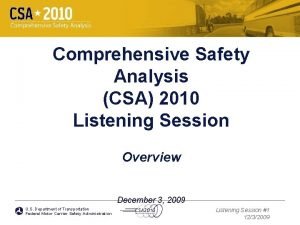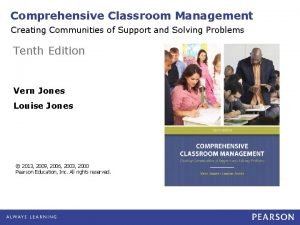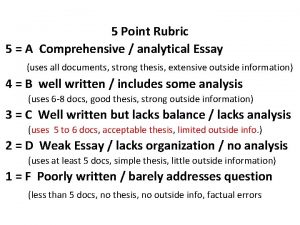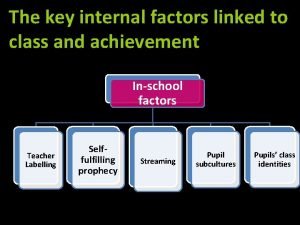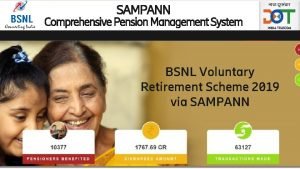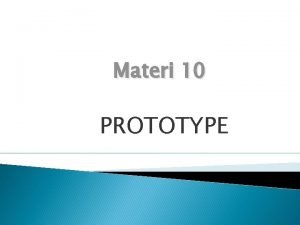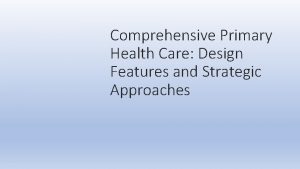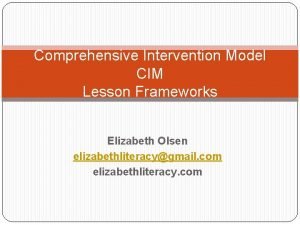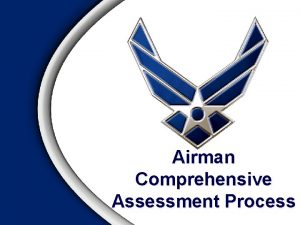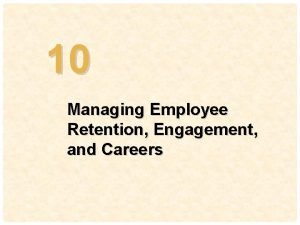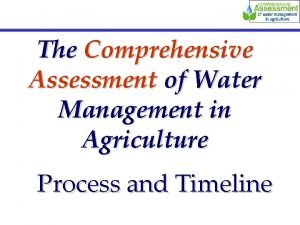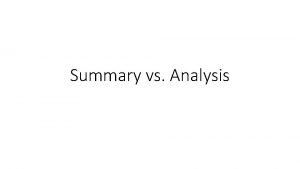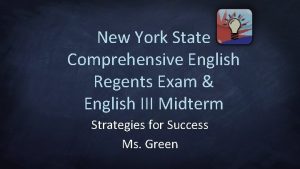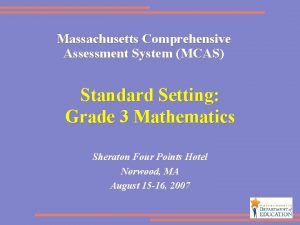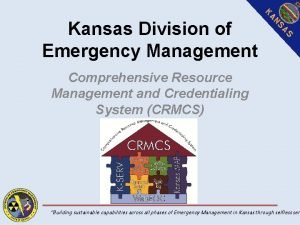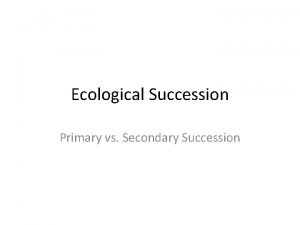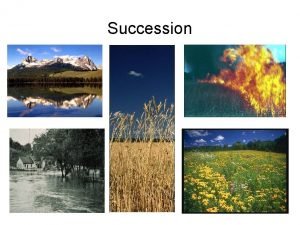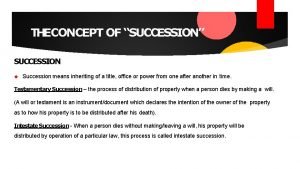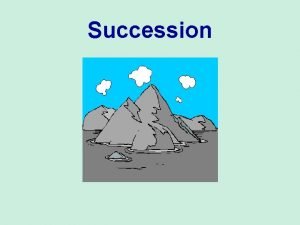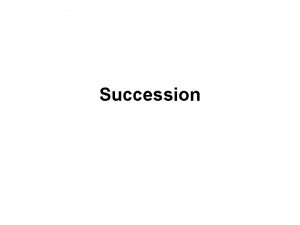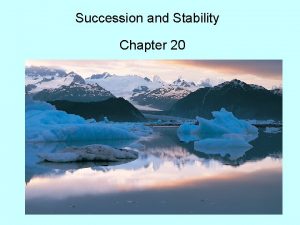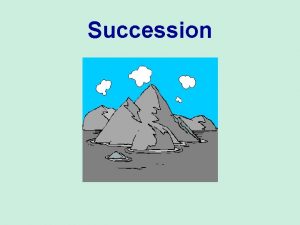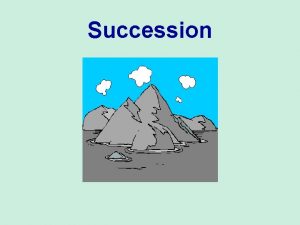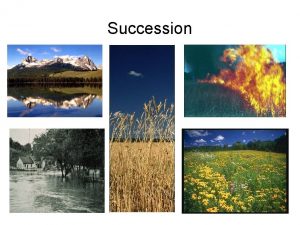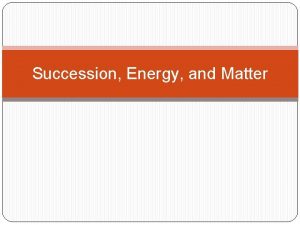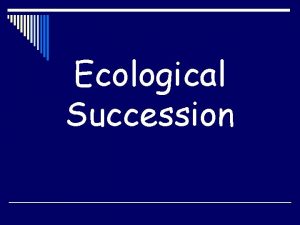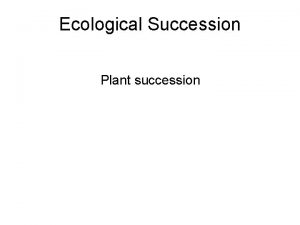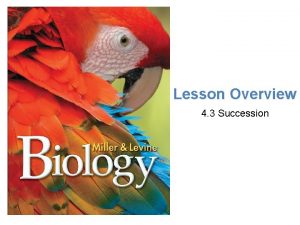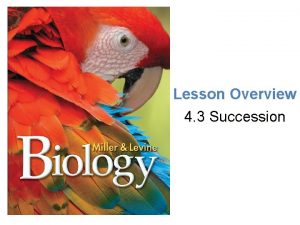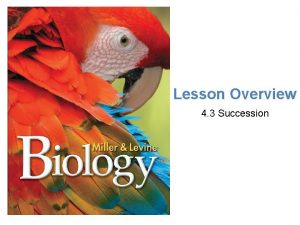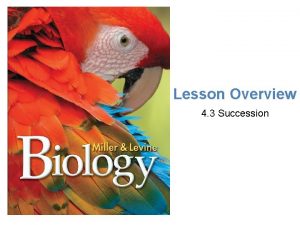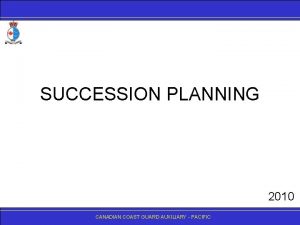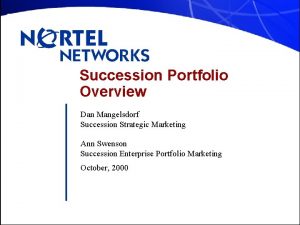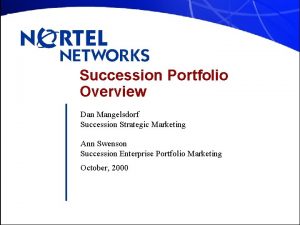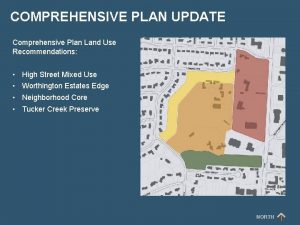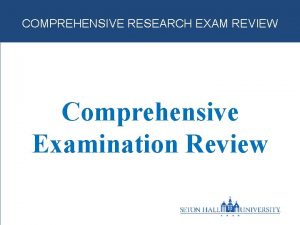Succession Plan Workshop Description Provides a comprehensive overview



















































- Slides: 51

Succession Plan

Workshop Description • Provides a comprehensive overview of Succession Planning and guidelines to address your needs • Provides details to prepare and implement a succession planning system

Workshop Objectives • To understand your role in succession planning • To clarify the importance of an organization's Succession Planning System • To identify and analyze critical positions requiring backups on a temporary or permanent basis • To learn how to compare individual appraisals of past and present performance with assessments of future individual potential • To examine methods of grooming high-potential employees for advancement by narrowing developmental gaps between present performance and future potential

Gain Buy In • Gain buy in from key stakeholders to sustain organizational support • Form committees to ensure the planning, implementation and follow-up is successful – – – Board Members and Executive Level Staff The Guiding Coalition HR Team and Individual Responsibilities Managers Potential Leaders and Employees

Your Role In Succession Planning • As a manager, it’s your role to ensure: • Identify key replacement needs and the high-potential people and critical positions to include in the succession plan • Clarify present and future work activities and work results • Compare present individual performance and future individual potential • Establish individual-development plans (IDPs) to prepare replacements and to develop high-potential workers

Definitions • Succession planning is defined as "any effort designed to ensure the continued effective performance of an organization, division, department, or work group by making provisions for the development and replacement of key people for key positions and work activities over time" (Rothwell, 1994, p. 5).

Need for Success Planning • Need for future growth and skill development • Proactive approach to fill key potential vacancies • Aligns mission with workplace planning strategy

Just-in-Time (JIT) Approach to Building the Leadership Pipeline Select Recruit Hire Advance and Promote Evaluate Results Retain Develop Train Classify jobs Manage Performance Compensate Transfer Knowledge

Integrated Approach to Building the Leadership Pipeline & ce r kfo or ning W an Pl c Su ion ss ce m Co te pe y nc i , H n io ct e l e el od t, S en M Re cr m uit Tr ai g& n i n g rin t en pm o l ve De n& r ee r Ca io ot m ro P Program Evaluation bil o M ion Re t ten ity t en em g na ed wl o Kn Ma e g n pe m Co n tio sa

Why the Integrated Approach • Many ways to build leadership pipeline • Because all aligned with strategic plan, workforce plan, competency model, and/or other frameworks, aligned with each other • Pipeline larger to meet demand for more talent

Integrated Approach Workforce & Succession Planning Recruitment, Hiring and Selection Competency Model Promotion and Career Mobility Training and Development Knowledge Management Program Evaluation Retention

Who’s in the Pipeline First Line Supervisors Middle Managers High Potentials and Replacement Pool for Senior Managers All Employees? Technical Specialists Time

Expanding the Pipeline • • • Cascading leadership succession planning Needs for competency development Employee demand Retention Leadership defined as a competency that employees at all levels are expected to develop

Five Questions to Ask? • Who’s in the leadership pipeline? • What are the most pressing developmental needs? • How are these needs being met? • What is the impact? • How are the efforts to build the leadership pipeline being evaluated?

Succession Planning Process – To create a system for succession planning that meets the needs of the organization and provides career growth opportunities for individuals based on their readiness, talent, and skills. – To identify key leadership competency behaviors, skills, and knowledge needed to prepare high potentials for future key leadership roles.

Talent Management • Talent management improves the skills and talents of and increases the performance of your team • Team members enjoy the feeling of personal growth and satisfaction that comes from the opportunity to develop their skills and better contribute to their team

Measure Results Job/Analysis Competency Development Hiring/Selection Employee Retention Leadership Development Process Succession Planning 360 Degree Feedback Talent Management Strategy Career Development Performance Management

Definition of Succession Planning “Succession planning is a means of identifying critical management positions starting at manager and supervisor levels and extending up to the highest position in the organization. ” William J. Rothwell Effective Succession Planning (2001) Succession planning should not and must not stand alone. It must be paired with succession management which creates a more dynamic environment.

Succession Planning and Management • A deliberate and systematic effort by an organization to: – ensure leadership continuity in key positions – retain and develop future intellectual and knowledge capital – encourage individual advancement – Integrated into the HR System – Succession Planning is managed to ensure success • Should also address the needs for critical backups and individual development in any job category

Succession Planning • Do you have an established succession plan? • Replacement versus Succession Planning • Do they have the skills and experience need to fill critical positions?

Succession Planning Components 2. HR Audit Develop a Pool of High Potential Candidates Monitor and Evaluate Progress and Results Make Adjustments 1. Replacement Planning Leadership Support Gain Buy-in from Senior Management Identify Top Leadership Experience, Education, and Job Experience Establish nomination criteria. Integrated Leadership Development Identify Readiness of Successors for Key Positions Review Performance and Development with Key Management Staff 3. Identify High Potential Successors 5. Create Development Opportunities Developmental Activities/Projects Mentoring/Coaching Create a Leadership Succession Plan Experience, Education, Manager/Mentor Recommendation 4. Identify Successor Developmental Needs Identify skills gap, set goals, create development plan Determine measurable goals and outcomes

Establishing a Succession Plan • Understand the critical position being vacated - what are the requirements of the job • Benchmark the job against future job requirements • Determine what the ideal candidate will look like • Evaluate potential replacements • Determine their performance and potential readiness level • Establish a Development Plan and Goals • Implement development plan • Provide Coaching and Feedback • Track and Monitor the plan

Steps in Succession Planning Process 1. 2. 3. 4. 5. 6. 7. 8. 9. 10. 11. 12. 13. 14. 15. Gain Buy-in from Senior Management Identify succession planning purpose and goals. Assess the organizations current and future business strategy and top leadership replacement needs. Identify and analyze key positions. Assess candidates against job and competency requirements. Identify development strategies. Define succession planning process and procedures. Communicate and implement succession planning. Collect information from employees regarding their career interests and expertise. Assess employee competencies. Create individual development plans. Select people to potential fill positions. Develop, select, and schedule training and development programs. Monitor progress. Measure and evaluate outcomes.

Succession Planning Policy • Identifying those employees who have the right skills to meet the challenges facing the organization • Evaluate the quality and “readiness” of named successors • Define development requirements and implement development plan • Review performance and development with key management staff • Make recommendations • Monitor and evaluate progress and results

Human Resource Assessment • Defines the leadership needs of the organization • Identifies qualification of successors and assesses employee capability and readiness to various positions • Helps designate a talent pool of candidates qualified for specific positions • Defines the developmental needs, competency and education requirements

Checklist to Succeed Part of an overall organizational culture strategy to develop managers at all levels. Ongoing commitment of high-level management. Part of an integrated HR process Identify what skills the organization will need in 5, 10 or 15 years Critical positions must be identified and included in the Company's Succession Planning program Analyze the workforce and identify who will be eligible for retirement within the next five years

Checklist to Succeed • Managers need to identify the responsibilities, skills and competencies that will be needed by their replacements Identify high-performers almost ready to step into those critical positions Identify specific behaviors, skills and values that leaders to succeed now and in the future. Use Assessment tools to make accurate leadership placement and development decisions. Establish a system for communicating succession planning information

Checklist to Succeed • Identify a systematic approach for identifying, nominating and selecting potential successors Review background information on potential successors, such as education, experience, skills, appraisals and potential Determine training and development requirements of potential successors Develop skills of potential successors through work experiences, job rotation, projects and other challenging assignments Establish a system for monitoring candidate's development plan progress by senior management Succession planning must include a system for providing feedback and encouragement to potential successors

Succession Planning • • • Identify High Potentials Create a Development Plan Implement the Plan Track the Plan Conduct Yearly Calibration Discussions with Your Manager, and HR to determine Readiness

Critical Position Profile • Interview someone in a current leadership role to determine their job requirements now and in the future. • This provides a profile of a successful candidate for this position

Successor’s Profile • Identify a successor’s job profile and experience to determine their current level of proficiency

Conduct a Gap Analysis • Analyze the potential successor’s experience level and compare to the advanced level job requirements

Define High Potential Characteristics • Results Driven – has completed many challenging assignments • People skill – Influences, motivates, works with a wide range of people. • Mental ability – Street smart, asks insightful questions • Lifelong Learning – seeks challenging opportunities for new knowledge, learns from successes and failures • Integrated thinking – Links ideas, sees essence of problem • Flexible – Adjusts priorities, takes risks, embraces change • Energy – gets energy from work and energizes others

Replacement Planning Process High potentials nominated as successors by managers, or Senior Management Senior management review the recommendations and make revisions An HR executive advisory group discusses replacement skill level, readiness, and potential to get a fairly accurate judgment of a person’s capability Recommendations made for potential replacement opportunities

Employee Input • Identify employee’s career interests, qualifications, and future job promotion interests on an employee input form • Track employee career interests and skill qualifications for future job opportunities • Career development discussions between managers and employees become part of the formal performance appraisal process

IDP Activity: Complete an IDP • Fill out the following form on an individual of your choice from your organization. • That person should be a “high potential”, someone who has the capability to advance to higher levels of responsibility and or develop increased proficiency in competence. • The form should indicate how you will help this person narrow the gap between how they presently perform and what he or she must do to qualify for advancement to a critical position.

IDP Activity: Complete an IDP • Fill out the following form on an individual of your choice from your organization. • That person should be a “high potential”, someone who has the capability to advance to higher levels of responsibility and or develop increased proficiency in competence. • The form should indicate how you will help this person narrow the gap between how they presently perform and what he or she must do to qualify for advancement to a critical position.

Leadership Development • • Mentoring for Success 360 Feedback Leadership Academy Performance Management Training & Development Competency Assessment College Degrees

Development Strategies • Identify career paths for future career growth • Identify competencies and assess strengths and areas for development • Have employees create a career profile and identify development plans • Mentor and coach employees • Provide ongoing feedback • Discuss career goals with employees • Develop a promotion from within policy

Leadership Development Program

Development Opportunities • • • Formal Training Advanced Degrees Certificate Programs Elearning On-the-Job Training Work Experiences Team Development Temporary Assignments Coaching Formal Mentoring

Leadership Model

High Potential Leadership Development Skill building • Degree programs • Leadership scholarships • Extraordinary leader program • Management classes Relationshipbuilding and knowledge • Executive retreat • Administrative manager/executive events • Management meetings • Leadership luncheons

Leadership Development Approach Executive Managers Administrative Extraordinary Leader Scholarships Middle Managers Professional Technical Degree Programs Management Development Managers Skill Building Knowledge and Relationship Building Executive Retreat Executive Events Exec/Admin events Management Meetings Leadership Luncheons = Target audience = Also invited

Types of Training • Formally educate employees on business issues, accounting practices and ethics • Identify and prioritize their greatest development needs • Invest wisely in training employees to carry out the mission

Coaching and Mentoring • Coaching is provided when performance needs improvement and is focused on job performance. Coaches helps individuals improvement performance • Mentoring is provided to help individuals grow in their professional experience. • Mentors provide one-on-one coaching to help Protégé’s identify areas that need development and establish goals. • Mentors provide guidance, support, feedback, direction, and share their experiences to help Protégé’s be successful in their current and future role.

Tracking Successors • Methods available: – Competency Assessment – Performance Appraisal – Mentoring Program – Career Experience and Development Activities – Training Records – 360 Feedback

Measure Success Define measurable goals during the planning stage Track goals regularly Adjust goals when needed Analyze progress and take corrective steps to improve goal performance • Analyze readiness, potential, performance, and replacements, employee morale, organizational culture, turnover, loss of talent, etc. • •

Building Your Leadership Pipeline Planning Model

Building Your Leadership Pipeline 1. 2. 3. 4. 5. 6. 7. Engage senior leaders Identify leadership competencies leaders Assess developmental needs Create leadership development strategy Use Individual Development Plans (IDPs) Tap into talent pool of eligible employees and recruit Don’t let cost keep you from building the pipeline

Succession Planning Software • Database tools for registering participants, assessing needs, determining the gaps, identifying areas for improvement, creating development plans, providing on-going feedback, identify progress, and tracking and measuring results. • Administrative tools help you manage the process, send emails, monitor progress, run reports, and maintain user information.
 Ecological succession succession of a pond
Ecological succession succession of a pond Ecological succession succession of a pond
Ecological succession succession of a pond Figure 12-1 provides an overview of the lymphatic vessels
Figure 12-1 provides an overview of the lymphatic vessels Comprehensive care plan
Comprehensive care plan Bellevue comprehensive plan
Bellevue comprehensive plan Evaluation plan
Evaluation plan Volusia county comprehensive plan
Volusia county comprehensive plan Fairfax county comprehensive plan
Fairfax county comprehensive plan Washington county comprehensive plan
Washington county comprehensive plan Church succession plan template
Church succession plan template Principles of succession planning
Principles of succession planning Church succession plan template
Church succession plan template Business plan writing workshop
Business plan writing workshop How to write a comprehensive report
How to write a comprehensive report Villanova premed
Villanova premed Washington comprehensive assessment program
Washington comprehensive assessment program Staxi-2 scoring
Staxi-2 scoring Comprehensive research meaning
Comprehensive research meaning What is operating income
What is operating income Comprehensive exams
Comprehensive exams Principles of remedial instruction
Principles of remedial instruction Clinical assessment
Clinical assessment Missouri comprehensive school counseling program manual
Missouri comprehensive school counseling program manual Missouri comprehensive school counseling program
Missouri comprehensive school counseling program Statement of comprehensive income btec business
Statement of comprehensive income btec business Exploring microsoft office excel 2016 comprehensive
Exploring microsoft office excel 2016 comprehensive Diagnosing groups and jobs
Diagnosing groups and jobs Drdp comprehensive view
Drdp comprehensive view Ctopp-2 percentile ranks
Ctopp-2 percentile ranks Comprehensive test of nonverbal intelligence
Comprehensive test of nonverbal intelligence Comprehensive safety analysis
Comprehensive safety analysis Explain in detail comprehensive interventions.
Explain in detail comprehensive interventions. Comprehensive classroom management
Comprehensive classroom management Comprehensive problem 1 part 8
Comprehensive problem 1 part 8 Hebburn comp uniform
Hebburn comp uniform What is an analytical expository essay
What is an analytical expository essay Banding at beachside comprehensive
Banding at beachside comprehensive Bsnl vrs pension sampann
Bsnl vrs pension sampann Definisi prototype
Definisi prototype Hierarchical reinforcement learning survey
Hierarchical reinforcement learning survey Comprehensive primary health care definition
Comprehensive primary health care definition Comprehensive intervention model
Comprehensive intervention model Airman comprehensive assessment
Airman comprehensive assessment Comprehensive model of personalised care
Comprehensive model of personalised care Comprehensive model of personalised care
Comprehensive model of personalised care Comprehensive approach to retaining employees
Comprehensive approach to retaining employees Comprehensive science major
Comprehensive science major Comprehensive assessment of water management in agriculture
Comprehensive assessment of water management in agriculture Analysis vs summary
Analysis vs summary Comprehensive english regents
Comprehensive english regents Body: massachusetts comprehensive assessment system
Body: massachusetts comprehensive assessment system Crmcs
Crmcs
